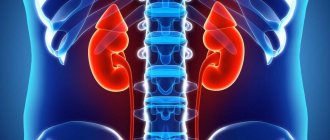- Description and causes
- Symptoms
- Diagnostics
- Treatment
- Prevention
Symphysitis is a pathology of the bone pelvis, consisting of an increase in the gap of the symphysis pubis , the development of pain in the symphysis and the inflammatory process in the tissues. Most often, the anomaly appears in the first period of gestation, and its severity increases as labor approaches. It is observed in 50% of pregnant women . In 25% of cases, symphysis requires treatment , and in 8% of women the disease causes impaired motor activity - temporary disability. In some women, pelvic pain continues after childbirth for 4-6 months.
Symptoms of symphysitis during pregnancy
The female pelvis is significantly different in structure from the male one. Representatives of the fairer sex have a special pubic joint in front - the symphysis - and two sacroiliac joints in the back. Their magical property is to make the pelvis mobile and expand when the time comes. The bones diverge and allow the baby to pass through the birth canal, thereby making his difficult journey easier. The male pelvis, of course, is not capable of this.
What is symphysitis during pregnancy? The symphysis looks like a disc, in the middle of which there is a cavity with articular fluid. It’s hard to imagine, but the tiny symphysis pubis, which is a maximum of one centimeter wide, can become damaged and inflamed. Changes in this half-joint are called the general term “symphysitis”, which reflects one or more processes out of a possible 16, for example, loosening, stretching, divergence, rupture, and so on.
The owner of a pelvis with an inflamed symphysis experiences painful pressure in the pubic area, as if the baby is already making its way out. This is usually encountered by pregnant women after the 30th week of pregnancy. In addition, among the signs and symptoms of symphysitis during pregnancy are strange pains in the pelvis, tailbone and hips, and a “duck-like” mincing gait characteristic of pregnant women. One of the ways to determine symphysitis during pregnancy is to press on the pubis, after which you can hear a strange crunching sound that frightens many women.
Diagnostics
Photo: uib.no
Diagnosis of symphysitis begins with collecting the patient’s complaints and medical history. After which the doctor prescribes a range of laboratory and instrumental examinations, the results of which will help make the correct diagnosis.
First of all, general laboratory tests are performed (general blood count, general urinalysis and biochemical blood test), which allow us to assess the general condition of the human body. With symphysitis, there is no specific change in indicators characteristic exclusively of this disease. Since one of the reasons for the development of symphysitis is a violation of calcium metabolism, special attention should be paid to the level of calcium in the blood.
During vaginal examination using a speculum, pain is noted in the area of the pubic symphysis. It is impossible to palpate a slight discrepancy in the symphysis; only when the distance between the pubic bones is more than 2.0 cm, which is typical for grade 3, the discrepancy is revealed in the form of a sensation under the fingers of a certain depression at the junction of the pubic bones.
The most accurate information about the distance between the pubic bones is provided by ultrasound examination of the symphysis pubis. The results of the study allow us to assess not only the severity of symphysitis, but also makes it possible to choose the method of delivery.
In the postpartum period, an X-ray examination of the pelvic bones is performed. The purpose of this study helps to assess the distance between the pubic bones, on the basis of which a conclusion can be made about the severity of the disease. In addition, the x-ray visualizes the displacement of the pubic bones, if any. The offset can be to the side or up/down in relation to each other. During pregnancy, the use of this diagnostic method is prohibited.
Diagnostic examinations are necessary to establish an accurate diagnosis, which allows you to determine further treatment tactics.
Causes of symphysitis
Doctors attribute symphysitis to a hereditary predisposition, lack of calcium in the body or hormonal changes - relaxin causes the articular cartilage to swell, making it too soft and mobile. However, the exact cause of the painful processes in the semi-joint has not yet been established. It would seem that these are natural processes of preparing the body for childbirth, facilitating the soft passage of the child through the birth canal, but if the joints become too mobile and the ligaments become too stretchable, doctors already speak of a pathological process. Often this even makes natural delivery impossible, and the woman has to have a caesarean section. Natural childbirth is acceptable if the dilation is no more than 10 millimeters (this is the norm for discrepancy), the woman’s pelvis is normal, and the size of the fetus corresponds to it.
The structure of the female pelvis
The pelvis is a closed ring formed by the pelvic bones, coccyx and sacrum. The pelvic bones are made up of the pubis, ilium and ischium. In addition to the main function - supporting the internal organs - the woman’s pelvis performs another very important function at one time - holding the baby during childbirth . Since the pelvis is adapted to perform this function, its cartilage and ligaments are able to “soften”. When a woman’s body releases a special hormone relaxin , the symphysis pubis, where the cartilage is located, also becomes softer and more mobile. As a result, the size of the pelvis gradually adjusts to the circumference of the child’s head.
Symphysitis and childbirth
Symphysitis does not leave a woman alone even after childbirth. There are several degrees of this diagnosis. At degree 1 – a discrepancy of 5-9 millimeters – the discrepancy practically does not bother its owner. At grade 2, the discrepancy is 10-20 millimeters, the woman feels quite acute pain in the area of the pubis and sacrum when moving. At grade 3, that is, more than 20 millimeters, the patient can no longer walk, move her legs, or even turn from one side to the other. The symphysis pubis hurts during pregnancy even at rest, which, of course, constantly worries and irritates the woman. The most serious complication is rupture of the ligaments and divergence of the symphysis pubis during pregnancy, which leads to the inability to walk or even stand.
The separation of the pubic bones can be seen on an x-ray. It cannot be done on pregnant women, so doctors make a diagnosis based on the patient’s complaints, and after the birth they check whether the diagnosis remains. The main symptom is pain in “that very place”, radiating to the hips. Symphysitis during pregnancy can be determined by a characteristic sign - it is painful for a woman to lift her straight leg from a lying position.
Aggravating factors
In addition to hormone production, there are several factors that provoke sprains of the pubic ligaments:
- disturbance of calcium-phosphorus metabolism;
- lack of vitamin D;
- increase in body mass index
- history of three or more pregnancies;
- injuries to the pelvic bones, even old ones;
- hereditary diseases of the musculoskeletal system;
- high fetal weight (the expected weight of the child at the time of birth is 4 kg or more);
- insufficient amount of physical activity of the mother.
Treatment of symphysitis
Photo source: shutterstock.com
Most often, there is no treatment for symphysitis during pregnancy and the disease heals with time. If measures to eliminate this diagnosis are taken on time, the prognosis for the disease is quite favorable. During pregnancy, excessive divergence of the pelvic bones is observed in 45% of expectant mothers; after their birth, this number decreases to 25%, and decreases significantly three months after the birth of the child. This is due to the stabilization of hormonal levels and a decrease in swelling of the pubic symphysis. The pain that has haunted the woman for so long also decreases.
It happens that excessive expansion occurs after the baby is born; this is the so-called postpartum symphysitis. It occurs as a result of the birth of a large fetus in a woman with a narrow pelvis, due to severe toxicosis or pathology of bone joints in the past. You can also get rid of postpartum symptoms of symphysitis with the help of a special bandage and a set of exercises. But too large a discrepancy will require special treatment, where physical therapy and medication are added to standard measures.
No pregnant woman is immune from symphysitis, even if such a diagnosis is not made by a doctor, pain may be present in the last weeks of the term. When the pelvic bones diverge, it is necessary to wear a special bandage, take calcium, appropriate vitamin complexes, and consume more dairy and fermented milk products. If inflammation is detected in the semi-joint, the woman takes antibacterial agents.
Prevention
special method for preventing symphysitis . To prevent the development of anomaly it is necessary:
- control weight;
- to live an active lifestyle;
- perform exercises to maintain the muscle corset and reduce pain ;
- eat a balanced diet, introducing foods high in K, Ca, Mg into your diet;
- take vitamin and mineral supplements outside the season of natural fruits and vegetables;
- avoid pelvic injuries.
exercises , which increase blood supply to the pelvic organs, stimulate the process of ossification, and strengthen the pelvic floor muscles, can prevent symphysitis .
Exercises for symphysitis
People often ask, is it possible to have sex with symphysitis? Unfortunately, symphysitis temporarily excludes intimate life: the pain syndrome either interferes with sex or appears immediately after sexual intercourse. In addition, experts advise climbing stairs as little as possible, not sitting in one place for more than an hour, especially in a cross-legged position, and very carefully monitoring weight gain, because every extra kilogram increases the load on the pelvis, spine and skeleton generally.
A set of special exercises for symphysitis during pregnancy will help prevent even greater separation of the bones, and at the same time reduce pain. If possible, it should be repeated several times daily.
- Starting position - on your back, feet pulled up to your buttocks, legs bent at the knees. 8-10 times we slowly spread our knees to the sides and bring them back.
- The starting position is the same, but the feet are a little further from the buttocks. We perform a gluteal bridge: carefully lift the pelvis up and down, also about 10 times.
- From the knee-elbow position, where the head and neck are at the same level as the pelvis, we arch our back and lower our head. Repeat 3-5 times.
- Starting position - sitting on a chair, knees hip-width apart, and between the thighs - something like a yoga brick (a small light ball will do). If you tightly squeeze an object with both legs for a short period of time, the inner surface of the thighs will be significantly strengthened, and the goal of the set of exercises is to tone all the muscles that are in any way connected with the pelvis.
- The starting position is the same, only now you need to get up from the chair, holding the object with your feet, maintain your posture, and sit back down. This will help stabilize the pelvic joints.
- The object is still there, but the initial position is standing against the wall. Leaning your back against the wall, you need to sit down as if on a chair, stretch your lower back, pressing it closer to the wall. At the same time, the tailbone is twisted inward, the muscles of the perineum are tightened. Repeat about 10 times.
The pain that plagues almost every second woman in the last weeks of pregnancy can be reduced. Here are a few points to pay attention to:
- A few weeks before giving birth, the expectant mother, as a rule, already knows what specific actions bring her pain. Doctors recommend tightening your pelvic floor muscles before each such activity, be it walking up the stairs or bending down to tie shoelaces.
- If you are going on a long walk or have to stand for quite a long time, tighten a regular belt at the level of the hip joints. You need to put it on with your feet hip-width apart, your feet parallel to each other. The belt should go under the stomach and not interfere with it in any way. But the accessory will “gather” the pelvic bones a little, thereby eliminating the pain from their divergence.
- Try doing some household chores while sitting rather than standing. For example, you can cook and iron while sitting comfortably on a chair. When lying down, place a pillow or a bolster made from a rolled blanket between your knees. If you know which specific activities cause pain, try to avoid them. At the end of the term, you can already afford to rest and relax a little.
- Try not to lift weights at all, and if you still have to do this, then only in a special bandage.
How to reduce pain intensity
After confirming the diagnosis, the doctor leading the pregnancy should give some tips and recommendations that will help reduce the level of pain.
Most often this is:
- use of a special bandage;
- taking medications containing calcium and vitamin D;
- monitoring weekly weight gain and monitoring weight in case of excessive work, as excess weight increases pain;
- adherence to a sleep and rest regime, in some cases complete physical rest should be adhered to;
- applying a warm heating pad to the area of the ligaments (here the doctor must tell you about the importance of maintaining a thermal regime);
- light massage at home;
- use of a special orthopedic pillow for the pelvic area;
- lightweight gymnast;
- swimming in the pool (in the absence of contraindications from the doctor).
In some cases, it is permissible to take painkillers. They are prescribed by a doctor. Self-administration of medications during pregnancy without consulting a specialist is prohibited.









